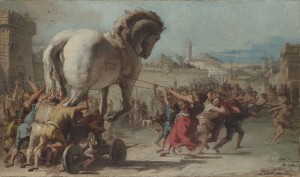
https://commons.wikimedia.org/wiki/File:Giovanni_Domenico_Tiepolo_-_The_Procession_of_the_Trojan_Horse_in_Troy_-_WGA22382.jpg
Achilles was viewed as an incredible warrior and an unbeatable force who would win any battle. That is because after birth, Achilles’ mother held tightly on to his heels and, according to legends, dipped him in the river Styx. The river was supposed to ensure Achilles’ mortality but the parts that were held by his mother did not touch the water. Achilles’ death had been foretold. Not long after Hector’s death, Achilles was working his way into Troy only to be killed reportedly by Paris who struck him in the heel with an arrow. Others believe it was Apollo, the God of the bow and arrow (Thomas, pg. 104).
The construction of the Trojan Horse was claimed to be the final tactic that would end the war. The Greeks constructed a large wooden horse, left it outside of the Trojan walls, and headed home, or so the Trojans thought. After ten years, they were in disbelief that the Greeks just packed up and went home. They decided to bring the horse inside the walls as an offering to Athena. Night fell and several Greek soldiers snuck out of the horse and opened the large gates for the rest of the Greek army who were waiting on a nearby island. Greek terror reigned down on Troy that night, ending in a victory. The city was burned down and the Trojan War, at last, was over. (Strauss, pg. 172)
